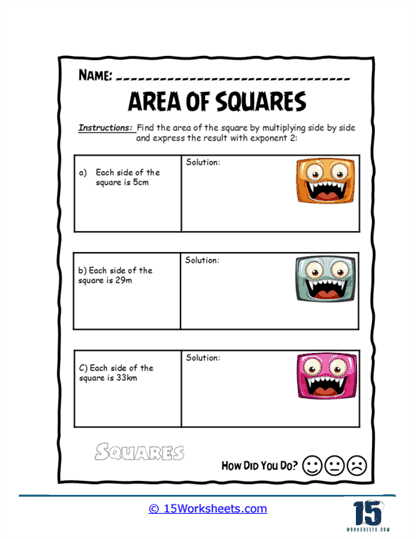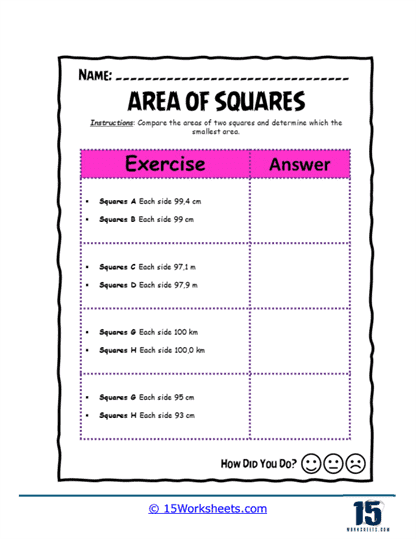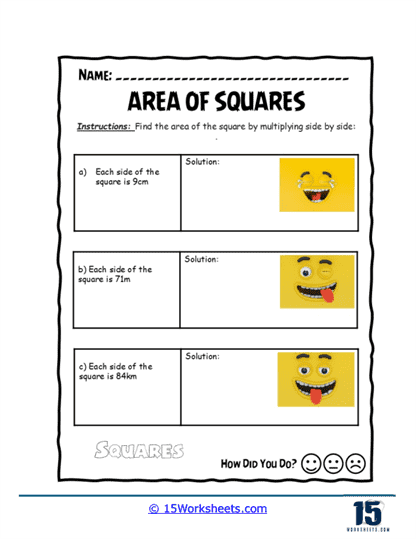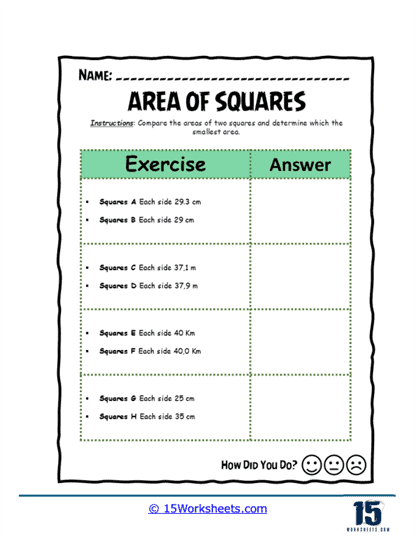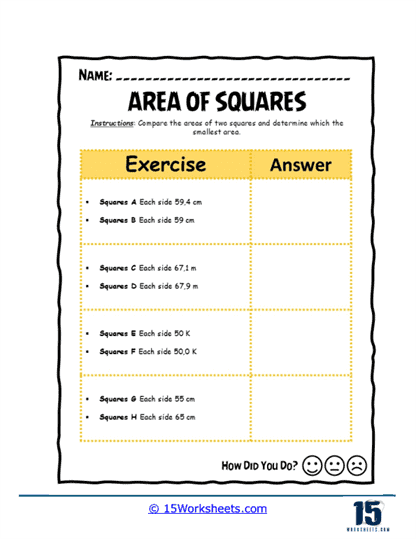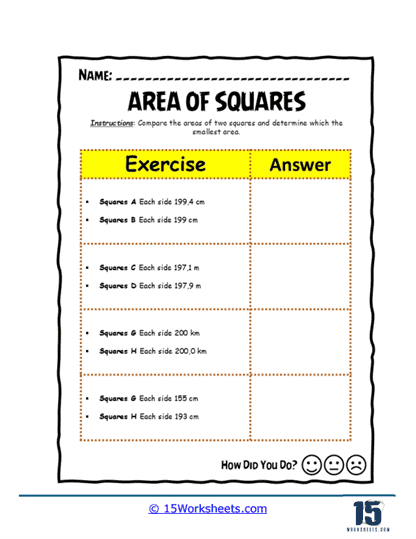Area of Squares Worksheets
About Our Area of Squares Worksheets
Understanding the area of squares is a fundamental concept in geometry that lays the groundwork for more complex mathematical principles. Whether students are just beginning their journey into geometry or reinforcing their knowledge, mastering the area of squares is essential for developing spatial reasoning, problem-solving skills, and practical applications in everyday life.
This comprehensive collection of printable worksheets is designed to provide students with structured, engaging, and interactive exercises focused on calculating and understanding the area of squares. These worksheets offer a variety of activities that cater to different learning styles, ensuring that students not only grasp the concept but also apply it in real-world contexts.
Ideal for classroom instruction, homework, tutoring sessions, or independent study, these worksheets are a valuable resource for teachers, parents, and students seeking clear, well-structured, and interactive math practice.
Skills Developed
By engaging with this worksheet collection, students will strengthen key mathematical and cognitive skills that are essential for academic success and everyday problem-solving. This structured approach ensures that learners not only memorize formulas but also develop a deep understanding of how these concepts apply to real-life situations. Through a variety of exercises, students will enhance their ability to calculate, analyze, and reason mathematically, setting a strong foundation for more advanced math topics.
1. Core Math Skills
Understanding Geometric Properties – Students will develop a strong grasp of the characteristics of squares, including how they relate to other geometric shapes. By recognizing and analyzing their properties, such as equal sides and right angles, learners will build a more comprehensive understanding of geometry. This foundation is crucial for progressing to more complex topics like area relationships, symmetry, and even three-dimensional shapes.
Applying the Area Formula – Mastering the formula for the area of a square (A = side²) is a fundamental skill that students will repeatedly apply throughout their math education. These worksheets provide structured practice to reinforce fluency in using the formula and recognizing when to apply it in different contexts. By engaging with exercises that require both direct calculations and conceptual reasoning, students develop confidence in their ability to work with geometric measurements.
Solving for Unknowns – In addition to straightforward calculations, students will encounter problems that require them to determine missing values, such as finding the length of a square’s side when given its area. These exercises help learners strengthen algebraic thinking skills by manipulating equations and understanding inverse operations. This ability to solve for unknowns is essential in higher-level math, including algebra, trigonometry, and calculus.
2. Critical Thinking and Problem-Solving
Logical Reasoning – Learning how to calculate the area of squares is more than just plugging numbers into a formula-it involves logical thinking and structured reasoning. These worksheets encourage students to analyze given information, determine the most efficient problem-solving approach, and apply mathematical logic to arrive at accurate solutions. Strengthening logical reasoning skills through these exercises benefits students not just in math but in science, technology, and real-world decision-making.
Analytical Thinking – Breaking down complex problems into smaller, manageable steps is a key aspect of analytical thinking, which these worksheets help students develop. Through step-by-step problem-solving activities, learners practice dissecting word problems, identifying key information, and systematically working through calculations. This analytical approach is essential for tackling advanced mathematical problems and applying mathematical concepts in practical settings.
Multi-Step Problem Solving – Many exercises in this collection involve multiple layers of calculation, such as determining the area of composite shapes that contain squares or working through real-world word problems. These problems challenge students to think critically and apply multiple math skills simultaneously. By working through these progressively challenging tasks, students build resilience and confidence in their ability to solve more advanced mathematical problems.
3. Real-World Math Application
Practical Use Cases – Understanding how to calculate the area of squares is a valuable skill that has numerous applications in everyday life. From measuring floor space for home improvement projects to designing artwork with geometric precision, students will see how this knowledge is relevant beyond the classroom. These worksheets include exercises that simulate real-world scenarios, helping learners connect abstract math concepts to tangible applications.
Measurement and Estimation Skills – Accurately measuring and estimating area is an essential skill in many fields, including construction, interior design, and engineering. Through hands-on activities and applied problem-solving, students will develop their ability to assess and compare square measurements. Strengthening estimation skills helps learners make quick, informed decisions in practical situations, such as purchasing materials for a project or planning the layout of a space.
Applying Math in Daily Life – Whether determining how many square tiles are needed for a floor or estimating the amount of fabric required for a craft project, understanding the area of squares is a useful real-world skill. These worksheets provide meaningful practice that helps students recognize the relevance of geometry in their everyday lives. By connecting mathematical learning to practical experiences, students are more likely to retain knowledge and feel confident applying it in real-world contexts.
Real-World Applications
One of the most valuable aspects of mastering the area of squares is its wide range of real-life applications. Many professions and industries rely on this fundamental concept, from engineering and construction to graphic design and interior decorating. By completing these worksheets, students will gain a deeper appreciation for how math is used beyond the classroom and will be better prepared to apply their skills in meaningful ways.
1. Home Design and Renovation
Whether planning a home renovation or organizing furniture layout, understanding square area is essential for efficient space management. These worksheets help students develop the ability to calculate the area of rooms, rugs, tiles, and wall sections, making them more prepared for real-world situations. Through engaging word problems and practical exercises, learners will recognize how math plays a critical role in everyday planning and decision-making.
Students will also explore the importance of area calculations in selecting materials, such as determining the amount of paint needed to cover a square-shaped wall or calculating how many tiles are required to cover a floor. By engaging with these real-world scenarios, learners will see how mathematical concepts translate into tangible applications.
For those interested in careers related to architecture, interior design, or real estate, mastering the area of squares is a foundational skill that will continue to be useful in professional settings. Developing confidence in these calculations can also help students make informed financial decisions when budgeting for renovations or home improvement projects.
2. Gardening and Landscaping
Gardening and landscaping projects often involve measuring and calculating the area of square plots for planting flowers, vegetables, or grass. These worksheets help students understand how to determine the amount of soil, mulch, or seeds needed based on the area of a garden bed. This practical application reinforces the real-world significance of geometry.
Understanding square area is also important in designing outdoor spaces, such as patios, walkways, or square-shaped ponds. By working through relevant exercises, students will strengthen their ability to plan and visualize spatial arrangements effectively.
These skills can be particularly valuable for individuals interested in careers related to landscaping, environmental design, or agricultural planning. By mastering area calculations at an early stage, students gain a strong mathematical foundation that supports future professional and personal endeavors.
3. Technology and Engineering
Engineers, graphic designers, and computer programmers frequently work with area measurements when designing layouts, blueprints, or user interfaces. By developing fluency in calculating the area of squares, students build a strong mathematical foundation that is applicable in STEM fields. These worksheets introduce scenarios that mirror the types of calculations professionals use in their daily work.
Computer-aided design (CAD) software, used in architecture and engineering, often requires precise area calculations to ensure accurate project execution. Understanding how to compute the area of squares and other shapes is a crucial skill for students aspiring to work in these fields.
By incorporating real-world problem-solving activities into these worksheets, students gain hands-on experience that connects mathematical learning to potential career paths. Whether designing websites, constructing bridges, or developing video game graphics, understanding area measurements is a skill that will remain useful in a variety of industries.
4. Business and Manufacturing
Many industries rely on area calculations to determine material costs, optimize production efficiency, and maximize resource usage. From textile manufacturers calculating fabric dimensions to factory workers determining packaging sizes, understanding square area is essential in business and manufacturing.
These worksheets introduce students to real-world problem-solving scenarios where they must calculate the area of square components in production processes. This exposure helps them appreciate how geometry plays a role in economic and industrial decision-making.
By practicing these calculations, students will also develop financial literacy skills, such as estimating expenses and optimizing resource allocation. Learning how to apply math to business contexts prepares students for real-world financial decision-making and fosters a stronger understanding of how mathematical principles drive industries forward.
Mastering the area of squares is a fundamental skill that extends far beyond the classroom, shaping students’ mathematical understanding and preparing them for real-world applications. Through structured practice, logical reasoning, and problem-solving exercises, these worksheets equip learners with the confidence and skills needed to tackle increasingly complex mathematical concepts. Whether applied in home renovation, gardening, engineering, or business, the ability to calculate and analyze square areas proves to be an invaluable asset. By engaging with these activities, students not only enhance their mathematical fluency but also develop practical knowledge that will benefit them in various academic, professional, and everyday scenarios.



